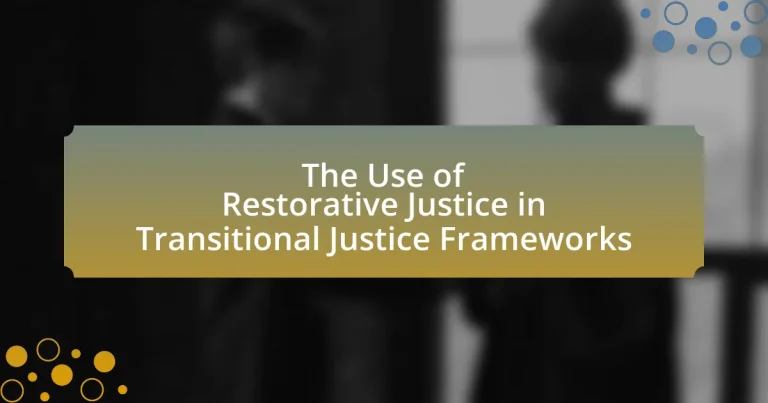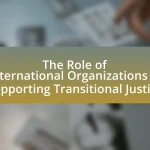Restorative justice is a vital component of transitional justice frameworks, focusing on healing, accountability, and community engagement following conflict or systemic injustice. This approach contrasts with retributive justice by prioritizing the repair of harm through dialogue and reconciliation, as evidenced by successful initiatives like South Africa’s Truth and Reconciliation Commission. Key principles of restorative justice include accountability, repair, and involvement, which facilitate victim-offender dialogue and community participation, ultimately fostering social cohesion and long-term peace. The article also addresses the challenges restorative justice faces, such as power imbalances and the need for effective implementation strategies, while highlighting successful case studies and future directions for enhancing restorative practices in transitional contexts.
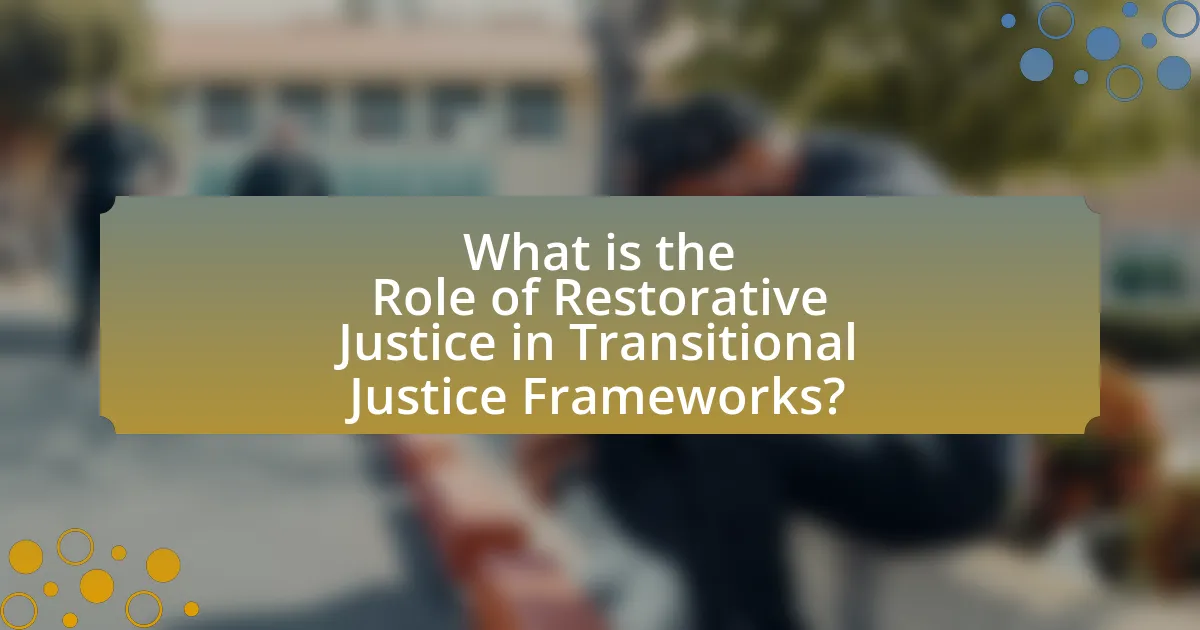
What is the Role of Restorative Justice in Transitional Justice Frameworks?
Restorative justice plays a crucial role in transitional justice frameworks by emphasizing healing, accountability, and community involvement in the aftermath of conflict or systemic injustice. This approach seeks to repair harm caused by wrongdoing through inclusive dialogue and reconciliation processes, allowing victims to share their experiences and perpetrators to acknowledge their actions. Evidence from various transitional justice initiatives, such as South Africa’s Truth and Reconciliation Commission, demonstrates that restorative justice can foster social cohesion and contribute to long-term peace by addressing the root causes of conflict and promoting mutual understanding among affected communities.
How does Restorative Justice differ from Retributive Justice in Transitional Contexts?
Restorative Justice focuses on repairing harm and fostering reconciliation among victims, offenders, and the community, while Retributive Justice emphasizes punishment and deterrence for the offender’s actions. In transitional contexts, Restorative Justice aims to address the underlying causes of conflict and promote healing, often involving dialogue and community participation, as seen in post-apartheid South Africa’s Truth and Reconciliation Commission. In contrast, Retributive Justice may exacerbate divisions by prioritizing punitive measures over restorative processes, potentially hindering societal healing and reconciliation efforts.
What are the key principles of Restorative Justice?
The key principles of Restorative Justice include accountability, repair, and involvement. Accountability emphasizes that offenders must take responsibility for their actions, acknowledging the harm caused. Repair focuses on addressing the needs of victims and the community, aiming to restore relationships and heal the harm done. Involvement encourages the participation of all stakeholders—victims, offenders, and community members—in the justice process, fostering dialogue and understanding. These principles are supported by various studies, such as those conducted by the International Institute for Restorative Practices, which highlight the effectiveness of restorative approaches in reducing recidivism and promoting victim satisfaction.
How do these principles apply in transitional justice scenarios?
Restorative justice principles apply in transitional justice scenarios by emphasizing accountability, healing, and community involvement. These principles facilitate dialogue between victims and perpetrators, fostering understanding and reconciliation, which is crucial in post-conflict societies. For instance, the Truth and Reconciliation Commission in South Africa utilized restorative justice to address past atrocities, allowing victims to share their experiences and perpetrators to confess, thereby promoting societal healing and reducing the likelihood of future violence. This approach has been shown to enhance social cohesion and restore trust in institutions, as evidenced by the positive outcomes reported in various transitional justice contexts globally.
Why is Restorative Justice important in post-conflict societies?
Restorative justice is important in post-conflict societies because it facilitates healing and reconciliation among individuals and communities affected by violence. This approach emphasizes repairing the harm caused by conflict through dialogue, accountability, and mutual understanding, rather than solely focusing on punishment. Research indicates that restorative justice processes can lead to lower recidivism rates and higher satisfaction among victims, as seen in various post-conflict settings like South Africa after apartheid, where truth and reconciliation commissions helped address grievances and foster social cohesion. By prioritizing restorative practices, post-conflict societies can rebuild trust, promote social stability, and create a foundation for sustainable peace.
What are the psychological benefits of Restorative Justice for victims?
Restorative Justice provides significant psychological benefits for victims, including enhanced emotional healing and a sense of closure. Victims often experience relief from the opportunity to express their feelings and narrate their experiences directly to the offender, which can lead to reduced feelings of anger and resentment. Research indicates that participation in restorative processes can improve victims’ mental health outcomes, as evidenced by a study published in the “Journal of Conflict Resolution” by scholars such as John Braithwaite, which found that victims who engage in restorative justice report higher levels of satisfaction and emotional well-being compared to those who go through traditional punitive systems. This engagement fosters a sense of empowerment and control over their healing process, contributing to overall psychological resilience.
How does Restorative Justice contribute to community healing?
Restorative Justice contributes to community healing by fostering dialogue and understanding among affected individuals, which helps to rebuild trust and relationships within the community. This approach emphasizes accountability and the active participation of victims, offenders, and community members in the healing process. Research indicates that communities engaged in Restorative Justice practices report lower recidivism rates and improved social cohesion, as seen in studies conducted by the National Institute of Justice, which found that restorative practices can lead to a 10-15% reduction in repeat offenses. By addressing the root causes of conflict and promoting reconciliation, Restorative Justice facilitates a collective healing process that strengthens community bonds.
What challenges does Restorative Justice face in Transitional Justice frameworks?
Restorative Justice faces several challenges in Transitional Justice frameworks, primarily including the tension between individual accountability and collective reconciliation. This challenge arises because Restorative Justice emphasizes healing and community involvement, which can conflict with the need for legal accountability and punishment for perpetrators of serious crimes. Additionally, there is often a lack of trust in the process among victims and communities, stemming from historical injustices and power imbalances, which can hinder participation and effectiveness. Furthermore, the integration of Restorative Justice into existing legal systems can be problematic, as traditional judicial processes may not align with restorative principles, leading to inconsistencies and confusion. These challenges are documented in various studies, such as the report by the United Nations on the effectiveness of restorative practices in post-conflict societies, which highlights the complexities of implementing restorative approaches alongside punitive measures.
What are the common criticisms of Restorative Justice in these contexts?
Common criticisms of Restorative Justice in transitional justice frameworks include concerns about power imbalances, lack of accountability, and potential victim re-traumatization. Critics argue that power dynamics can skew the process, favoring perpetrators over victims, which undermines the intended goals of justice and healing. Additionally, some believe that restorative justice may allow offenders to evade traditional punitive measures, leading to insufficient accountability for serious crimes. Furthermore, the emotional and psychological impact on victims can be significant, as engaging with offenders may trigger trauma rather than facilitate healing. These criticisms highlight the complexities and challenges of implementing restorative justice effectively in transitional contexts.
How can these challenges be addressed effectively?
Restorative justice challenges in transitional justice frameworks can be effectively addressed by implementing inclusive dialogue processes that engage all stakeholders. These processes foster understanding and reconciliation, as evidenced by the success of the Truth and Reconciliation Commission in South Africa, which facilitated open discussions about past injustices and promoted healing. Additionally, training facilitators in restorative practices ensures that dialogues are conducted in a manner that respects all voices, thereby enhancing the legitimacy and effectiveness of the restorative justice approach.
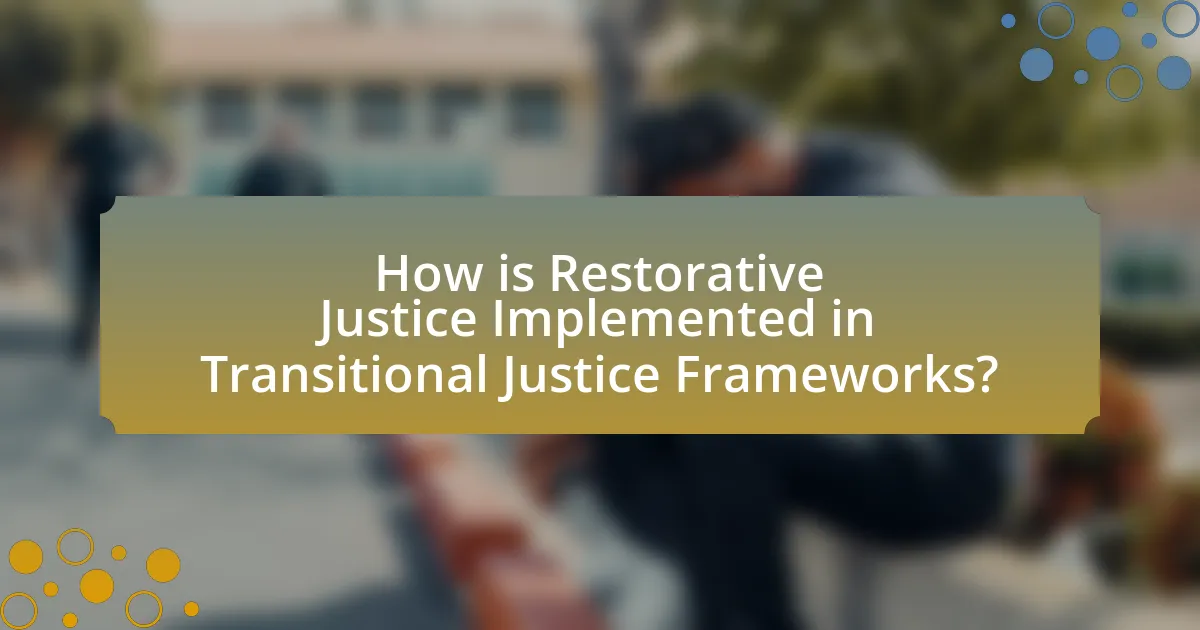
How is Restorative Justice Implemented in Transitional Justice Frameworks?
Restorative justice is implemented in transitional justice frameworks through mechanisms that prioritize dialogue, accountability, and healing among victims, offenders, and communities. These frameworks often include truth commissions, community-based reparations, and restorative dialogues that facilitate understanding and reconciliation. For instance, South Africa’s Truth and Reconciliation Commission exemplifies this approach by allowing victims to share their experiences and offenders to acknowledge their actions, fostering a collective healing process. This implementation is supported by the recognition that addressing past injustices through restorative practices can contribute to sustainable peace and social cohesion in post-conflict societies.
What are the steps involved in implementing Restorative Justice?
The steps involved in implementing Restorative Justice include identifying the stakeholders, facilitating dialogue, developing a plan for accountability, and monitoring outcomes. First, stakeholders such as victims, offenders, and community members must be identified and engaged to ensure their participation. Next, a dialogue is facilitated to allow all parties to express their feelings and perspectives, fostering understanding and empathy. Following this, a plan for accountability is developed, which outlines the responsibilities of the offender to make amends. Finally, outcomes are monitored to assess the effectiveness of the restorative process and ensure that the needs of all parties are met. These steps are essential for creating a successful restorative justice framework that promotes healing and reconciliation.
How do stakeholders engage in the Restorative Justice process?
Stakeholders engage in the Restorative Justice process by participating in dialogues that focus on repairing harm and fostering understanding among victims, offenders, and the community. This engagement typically involves victims sharing their experiences, offenders taking responsibility for their actions, and community members facilitating discussions to promote healing. Research indicates that such inclusive dialogues can lead to higher satisfaction rates among victims and lower recidivism rates for offenders, demonstrating the effectiveness of stakeholder involvement in achieving restorative outcomes.
What role do facilitators play in this implementation?
Facilitators play a crucial role in the implementation of restorative justice within transitional justice frameworks by guiding discussions, ensuring equitable participation, and fostering a safe environment for dialogue among stakeholders. Their expertise in conflict resolution and mediation helps to navigate sensitive issues, allowing victims, offenders, and community members to engage constructively. Research indicates that effective facilitation can enhance the outcomes of restorative processes, as seen in various case studies where trained facilitators led successful restorative justice initiatives, resulting in higher satisfaction rates among participants and improved community relations.
What are the best practices for successful Restorative Justice programs?
Successful Restorative Justice programs prioritize community involvement, victim participation, and offender accountability. Engaging the community fosters a supportive environment that encourages dialogue and healing, while victim participation ensures that the needs and voices of those harmed are central to the process. Offender accountability is crucial, as it promotes responsibility for actions and encourages personal growth. Research indicates that programs incorporating these elements lead to higher satisfaction rates among victims and lower recidivism rates among offenders, demonstrating their effectiveness in achieving restorative outcomes.
How can cultural considerations enhance Restorative Justice initiatives?
Cultural considerations can enhance Restorative Justice initiatives by ensuring that the processes are relevant and respectful to the communities involved. When cultural values and practices are integrated into Restorative Justice frameworks, they foster greater participation and acceptance among community members. For instance, research indicates that incorporating indigenous practices in Restorative Justice can lead to more effective outcomes, as seen in the work of scholars like John Braithwaite, who emphasizes the importance of cultural context in achieving justice. This alignment with cultural norms not only promotes healing but also strengthens community ties, making the justice process more meaningful and impactful.
What metrics can be used to evaluate the effectiveness of these programs?
Metrics to evaluate the effectiveness of restorative justice programs in transitional justice frameworks include recidivism rates, victim satisfaction surveys, offender accountability measures, and community engagement levels. Recidivism rates provide insight into the long-term impact of restorative justice on reducing reoffending, with studies indicating that restorative practices can lead to lower rates compared to traditional punitive measures. Victim satisfaction surveys assess the perceived fairness and emotional healing experienced by victims, which is crucial for understanding the program’s impact on those directly affected. Offender accountability measures evaluate how well offenders take responsibility for their actions and engage in reparative actions, reflecting the program’s success in fostering personal accountability. Lastly, community engagement levels indicate the extent to which the community is involved in the restorative process, which can enhance social cohesion and support for the justice system.
What case studies exemplify successful Restorative Justice in Transitional Justice?
Successful case studies of Restorative Justice in Transitional Justice include South Africa’s Truth and Reconciliation Commission (TRC) and the Gacaca courts in Rwanda. The TRC, established in 1995, aimed to address human rights violations during apartheid by promoting dialogue and forgiveness, resulting in over 7,000 statements from victims and perpetrators, fostering national healing. The Gacaca courts, initiated in 2001, facilitated community-based trials for genocide-related crimes, leading to the resolution of over 1.9 million cases and emphasizing accountability and reconciliation within local communities. These examples demonstrate the effectiveness of Restorative Justice in promoting healing and social cohesion in post-conflict societies.
What lessons can be learned from these case studies?
The lessons learned from case studies on the use of restorative justice in transitional justice frameworks include the importance of community involvement, the effectiveness of dialogue in healing, and the necessity of addressing victims’ needs. Community involvement fosters ownership of the justice process, as seen in South Africa’s Truth and Reconciliation Commission, which engaged communities to promote national healing. Dialogue has proven effective in facilitating understanding and reconciliation, as demonstrated in the case of Rwanda, where community-based approaches helped rebuild trust. Additionally, addressing victims’ needs is crucial for successful outcomes, as evidenced by programs in Colombia that prioritize victim participation and acknowledgment of their suffering, leading to more sustainable peace.
How do these examples inform future practices in similar contexts?
These examples inform future practices in similar contexts by demonstrating the effectiveness of restorative justice in fostering reconciliation and healing in post-conflict societies. For instance, the Truth and Reconciliation Commission in South Africa highlighted how restorative approaches can facilitate dialogue between victims and perpetrators, leading to a deeper understanding of the past and promoting social cohesion. Research indicates that such frameworks can reduce recidivism rates and enhance community trust, as evidenced by studies showing that restorative justice programs in various countries have led to improved outcomes for both victims and offenders. Therefore, integrating restorative justice principles into transitional justice frameworks can enhance their effectiveness and sustainability.
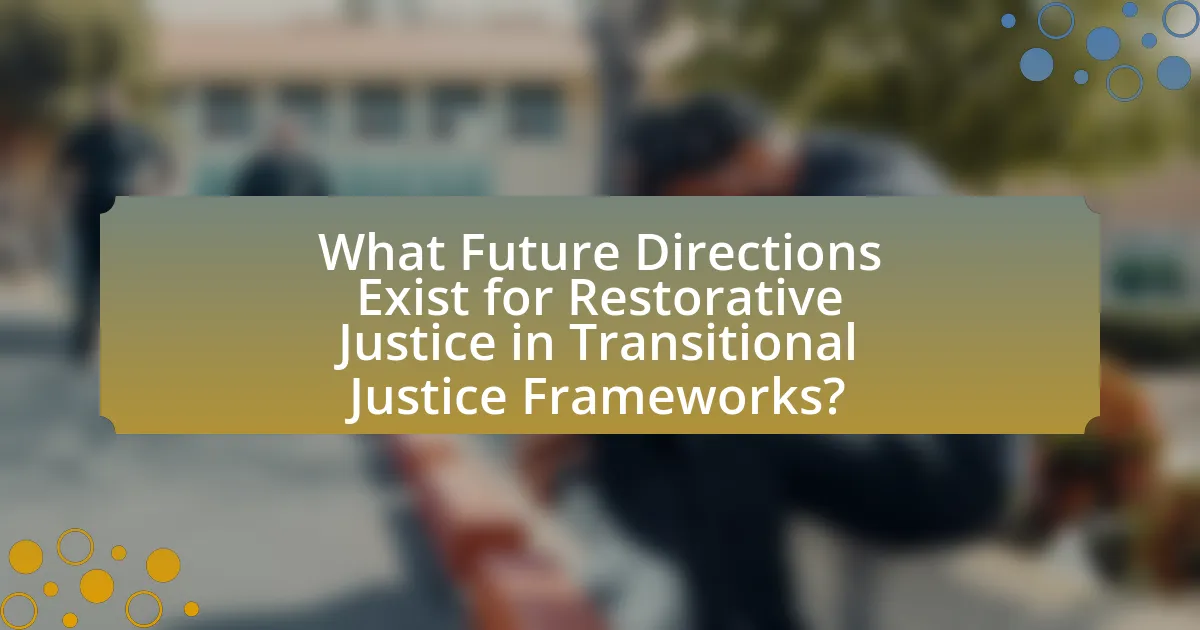
What Future Directions Exist for Restorative Justice in Transitional Justice Frameworks?
Future directions for restorative justice in transitional justice frameworks include the integration of community-based approaches, the incorporation of indigenous practices, and the emphasis on victim-centered processes. Community-based approaches can enhance local ownership and participation, fostering healing and reconciliation at the grassroots level. Incorporating indigenous practices acknowledges cultural contexts and promotes traditional conflict resolution methods, which can be more effective in certain communities. Additionally, emphasizing victim-centered processes ensures that the needs and voices of victims are prioritized, leading to more meaningful outcomes. These directions are supported by case studies from countries like South Africa and Rwanda, where restorative justice elements have been successfully integrated into transitional justice efforts, demonstrating their potential for fostering long-term peace and social cohesion.
How can Restorative Justice evolve to meet emerging challenges?
Restorative Justice can evolve to meet emerging challenges by integrating technology and community engagement into its practices. The incorporation of digital platforms facilitates broader participation in restorative processes, allowing victims, offenders, and community members to connect and communicate effectively, even remotely. For instance, virtual mediation sessions can increase accessibility for individuals who may face barriers to in-person meetings. Additionally, community engagement initiatives can be enhanced through partnerships with local organizations, ensuring that restorative practices are culturally relevant and responsive to the specific needs of diverse populations. Evidence from various restorative justice programs indicates that such adaptations lead to higher satisfaction rates among participants and improved outcomes in terms of accountability and healing.
What innovations are being explored in Restorative Justice practices?
Innovations in Restorative Justice practices include the integration of technology, such as virtual conferencing for mediation, and the development of community-based programs that emphasize healing over punishment. These innovations aim to enhance accessibility and effectiveness in addressing harm. For instance, studies have shown that online restorative justice circles can facilitate participation from individuals who may otherwise be unable to attend in-person meetings, thereby increasing engagement and outcomes. Additionally, the incorporation of trauma-informed approaches is being explored to better support victims and offenders, ensuring that emotional and psychological needs are addressed during the restorative process.
How can technology support Restorative Justice initiatives?
Technology can support Restorative Justice initiatives by facilitating communication, enhancing accessibility, and providing data analysis tools. For instance, online platforms enable victims, offenders, and community members to engage in dialogue and mediation processes remotely, which can increase participation rates. Additionally, technology can offer virtual reality simulations that help participants understand the impact of crime and foster empathy. Data analysis tools can track outcomes and measure the effectiveness of restorative practices, providing evidence-based insights that can improve future initiatives. Research indicates that these technological applications can lead to higher satisfaction rates among participants and more successful resolutions in restorative justice processes.
What role do policymakers play in shaping the future of Restorative Justice?
Policymakers play a crucial role in shaping the future of Restorative Justice by establishing legal frameworks and funding initiatives that promote its implementation. They influence the adoption of restorative practices through legislation, such as the inclusion of restorative justice principles in criminal justice systems, which can lead to reduced recidivism rates; for example, studies show that restorative justice programs can lower reoffending by up to 27%. Additionally, policymakers can allocate resources for training practitioners and developing community-based programs, ensuring that restorative justice is accessible and effective. By engaging with stakeholders, including victims, offenders, and community members, policymakers can create inclusive policies that reflect the needs and values of society, ultimately guiding the evolution of restorative justice practices.
How can legislation support the integration of Restorative Justice in transitional processes?
Legislation can support the integration of Restorative Justice in transitional processes by establishing legal frameworks that mandate restorative practices in post-conflict settings. Such frameworks can include provisions for community-based reconciliation programs, victim-offender mediation, and the establishment of restorative justice courts, which facilitate dialogue and healing between victims and offenders. For instance, the South African Truth and Reconciliation Commission, established through legislation, incorporated restorative justice principles to address the harms of apartheid, demonstrating how legal mandates can operationalize restorative approaches in transitional justice. This legal backing not only legitimizes restorative practices but also ensures that they are systematically implemented, monitored, and evaluated, thereby enhancing their effectiveness in promoting social cohesion and healing in societies recovering from conflict.
What advocacy efforts are necessary to promote Restorative Justice?
Advocacy efforts necessary to promote Restorative Justice include raising public awareness, engaging policymakers, and providing training for practitioners. Raising public awareness involves educating communities about the benefits of Restorative Justice, which can lead to reduced recidivism rates and improved victim satisfaction, as evidenced by studies showing that restorative practices can decrease repeat offenses by up to 30%. Engaging policymakers is crucial for integrating Restorative Justice into legal frameworks, as demonstrated by successful legislative changes in countries like New Zealand, where restorative practices have been incorporated into youth justice systems. Additionally, providing training for practitioners ensures that those implementing Restorative Justice are equipped with the necessary skills and knowledge, which has been shown to enhance the effectiveness of restorative programs.
What practical tips can be applied for implementing Restorative Justice in Transitional Justice?
Practical tips for implementing Restorative Justice in Transitional Justice include fostering community involvement, ensuring victim participation, and promoting dialogue between conflicting parties. Community involvement can be achieved by engaging local leaders and organizations to facilitate discussions and build trust among stakeholders. Victim participation is crucial; providing platforms for victims to share their experiences ensures their voices are heard and acknowledged, which is supported by studies showing that victim engagement enhances the legitimacy of justice processes. Promoting dialogue encourages understanding and reconciliation, as evidenced by successful restorative justice programs in countries like South Africa, where truth commissions facilitated open conversations about past injustices.
